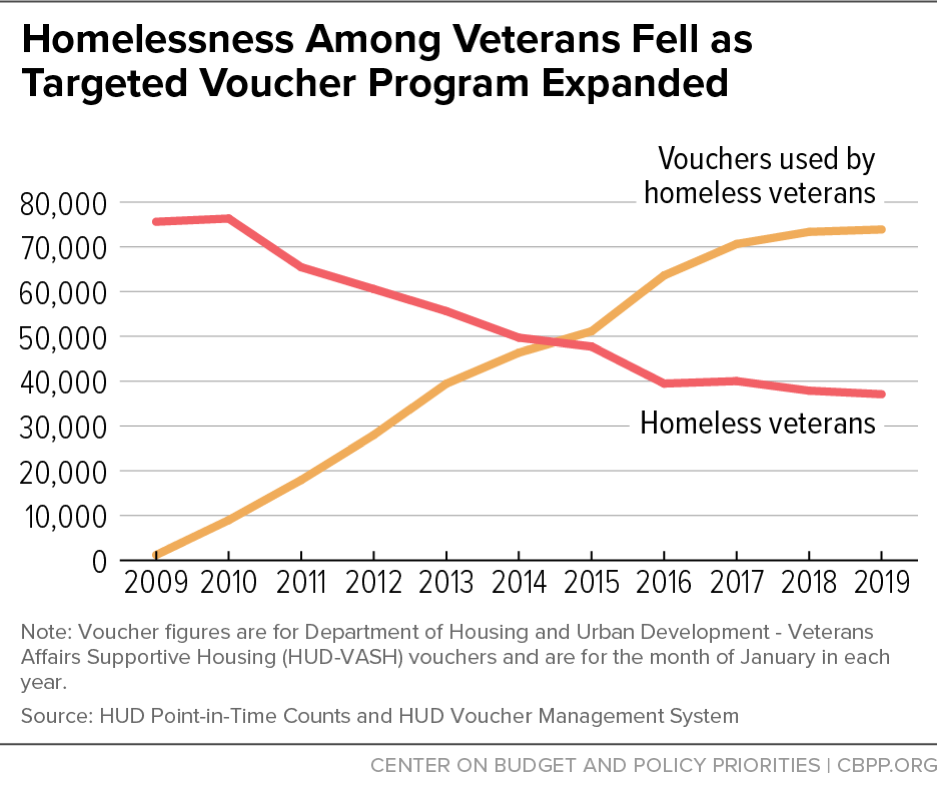BEYOND THE NUMBERS
Budget Exposes Trump Administration’s Empty Rhetoric on Homelessness, Fair Housing
The Trump Administration has said that it wants to help communities address the nation’s serious housing affordability challenges, but the President’s 2021 budget would do the opposite, slashing housing assistance and community development aid next year by $8.6 billion, or 15.2 percent (not counting the impact of inflation).
The President last fall reportedly called for a “crackdown” on homelessness in Los Angeles and threatened federal intervention, seemingly intending to abandon proven, evidence-based strategies to help reduce homelessness. More recently, the Administration defended its proposal to roll back the enforcement of communities’ fair housing obligations by declaring that expanding the supply of affordable housing would better advance such goals.
But, for the Department of Housing and Urban Development (HUD) — much like in the President’s first three budgets — the budget proposes massive cuts in rental housing aid, which would leave hundreds of thousands more seniors, families with children, and other low-income households struggling to afford their rent and, in turn, likely worsen homelessness.
The budget would:
- Slash public housing funding by $3.2 billion, or 43 percent, in 2021. Such cuts would prevent housing agencies from keeping hundreds of thousands of units in healthy, safe condition, putting low-income residents at risk and accelerating the permanent loss of public housing developments. Such developments are a critical source of affordable homes for nearly 1 million households, mostly seniors and people with disabilities.
- Eliminate funding for about 160,000 Housing Choice Vouchers that seniors, families with children, and others use to rent decent, stable homes at an affordable cost. This enormous loss of affordable housing would undermine local efforts to reduce homelessness and meet other urgent housing needs. That’s because many communities — including Los Angeles, which the Administration chastised for not doing enough to address homelessness — use housing vouchers to help people move from streets or shelters into stable housing.
- Cut, rather than expand, funding for homelessness efforts. Overall, the budget would cut homeless assistance grants by $4 million (0.1 percent). While the budget increases funding to continue supportive housing and other local “continuum of care” programs (and, depending on program renewal costs, possibly expand them modestly), the budget cuts funding for other types of homeless assistance grants. Most significantly, it would eliminate $130 million in targeted grants to help homeless youth and victims of domestic violence.
- Eliminate the National Housing Trust Fund, Home Investment Partnerships, Community Development Block Grant, and Choice Neighborhoods programs. Together, these programs provide more than $5 billion per year in flexible resources that communities use to build and rehabilitate affordable housing.
- Impose sharp rent increases on 4 million low-income households to partly offset the budget’s very deep cuts in housing vouchers and other rental assistance and help cover rental assistance program costs. That would force working families, the elderly, people with disabilities, and others to divert money from their other basic needs and put some of them at risk of eviction and homelessness. Our 2018 analysis of this proposal is here.
The need for more housing affordability resources, not fewer, is striking. Some 11 million renter households pay more than half their income for rental costs, and more than half of these households have incomes of less than $15,000 per year. Meanwhile, only 1 in 4 eligible low-income households receives rental assistance due to funding limits. Those that do get assistance find it a critical resource. Housing vouchers and other HUD rental aid are key to reducing homelessness; the HUD-Veterans Affairs Supportive Housing voucher program, for instance, has reduced veterans’ homelessness by 50 percent since 2010. (See chart.) More broadly, HUD’s rental assistance programs account for more than half of the affordable rental housing available to extremely low-income households.
The HUD budget contains a few positive proposals. It would increase funding by $70 million to reduce lead hazards in housing, and by $60 million for initiatives that promote employment and increased earnings among assisted residents, in particular the Family Self Sufficiency and Jobs-Plus programs. It also proposes $110 million to modestly expand affordable housing for seniors and people with disabilities through the Section 202 and 811 programs, respectively. But its $80 million in cuts to housing assistance for people with HIV/AIDS, together with housing voucher cuts, would significantly reduce the number of seniors and people with disabilities receiving rental assistance.
Congress should reject this budget and instead continue to make strong investments in proven strategies to address the nation’s housing needs.

